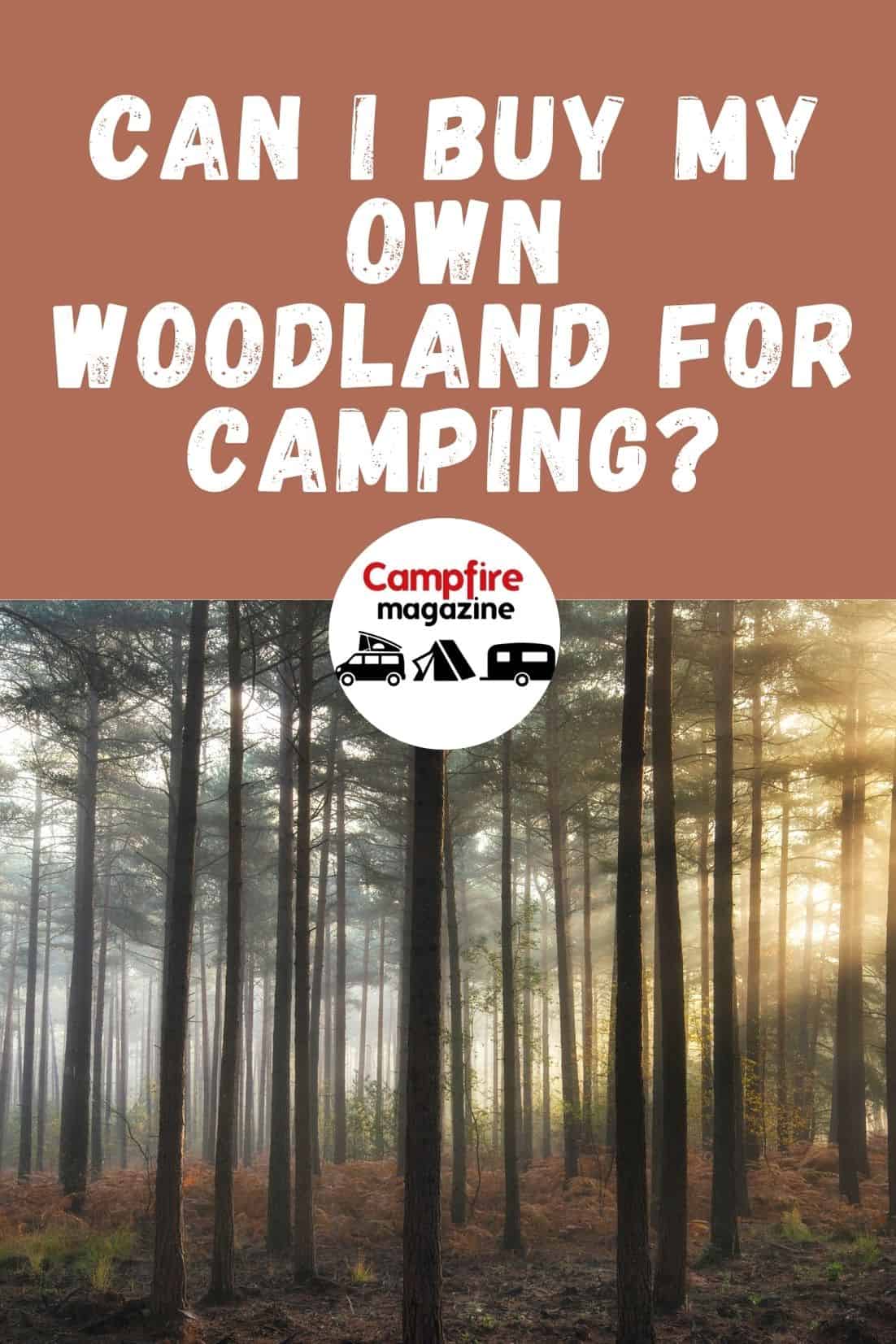Let’s say you love a particular part of the country and you camp there as often as you can. Trouble is, you’re not that keen on the campsites you’ve found. Wouldn’t buying your own woodland be the answer?
We’ve been chatting to the experts to get some answers for you.
Latest update: March 2021
All our reviews at Campfire Magazine are independent and honest.

Woods for sale?
Ed Midmore of Woods4Sale tells us that more and more people are deciding to buy a woodland just for the pleasure of it.
Some want some peace and tranquility, some want to play their part in rewilding a small patch of the country. Then there are coppicers, wildlife-spotters, den-makers…but what about campers?
In fact, in England and Wales you can only camp in your wood for 28 days a year – after that you need planning permission or be prepared to take a risk of upsetting your neighbours.
Even in Scotland, where wild camping in tents is usually allowed, the code states it should be “lightweight, done in small numbers and only for two or three nights in any one place.” Parking a campervans or motorhome doesn’t class as wild camping, so doesn’t enjoy the same rights.
“If you own a woodland you can stay for up to 28 days of the year without any planning permission,” confirms Ed. “This could be in a tent, caravan, campervan or motorhome. The rule is there to stop people actually living full-time in their woodlands, and it’s extremely unlikely that residential planning permission would ever be granted in a woodland.”
A log cabin or other structure is only allowed if it’s there JUST for forestry work – to store tools, for a forest school, as a shelter when you’re pruning, making charcoal and so on. And you need permission.
It’s not about the money, but…
Ed also mentions that, overall, woodlands have increased in value by around eight per cent a year over the past 20 years, according to figures from the UK Forestry Index.
It’s thought of as a pretty stable investment and there’s no inheritance tax providing the owner lives for two years or more after the purchase. Income from the sale of timber is free of income tax, and there’s no capital gains tax on the growth of the trees on your land. There is tax to pay on renting the land for things like shooting innocent birds and animals (and guilty ones, for that matter).
Remember that tax regulations can change, so please don’t sign away your savings without checking on the latest position! You can also claim land for free in the UK, this takes a lot more time though.
Some useful reading
How to buy a wood – what you need to know
1. Boundaries
Every wood joins something. Your neighbours are most likely to be other wood-owners (see point 8) or farmers. If there’s livestock, you need to check about liability for fencing. Check who’s responsible before buying your wood.
2. Insurance
You’ll need insurance to cover things like injury to others. Even if people are in your wood without permission, you could be liable. Specialised insurance is available via the Small Woods Association, which is worth joining for the wealth of knowledge you can tap into.
3. Public access
If there are existing public footpaths, bridleways and byways, you need to keep these open and useable. Rules vary slightly between England and Wales and Scotland. Scotland’s right to roam act states that “you have the right to access most land and inland water including mountains, moorland, woods and forests, grassland, fields, rivers and lochs, coastal areas, most parks and open spaces, golf courses (to cross them); day and night, providing you do so responsibly”. In England and Wales, once you own the woodland, it’s private land except in the case of footpaths or bridleways and other rights of way.
4. Grants
There are no grants for purchase but a few for management – they can be complex and time-consuming to apply for, though. You can find out more at the Woodlands Trust or Small Woods Association.
5. Diseases like ash dieback
You’ll be responsible for dealing with disease if your wood is affected. That could mean felling and burning. The disease outlook for ash, oak and larch in this country isn’t good because of transmission through spores and the warming climate.
Ed says: “Organisations such as the Woodland Trust and Forestry Commission/NRW in Wales have loads of support and information regarding issues such as ash dieback. It’s important to keep your eye out for unusual signs such as dieback in the canopy or leaf discolouration out of season. observatree.org.uk has good information on their website and even an iPhone app so you can report any suspicious sightings.”
6. Size
Ed says one to five acres is about right. Seabury and Shirley Salmon own a large wood in Wales. They say: “A couple of acres in the right place is enough for seclusion and a big play area. Thereafter, whatever feels ‘right’ for you. Always be aware of designations like SSSI, which can limit what you do in the place and how neighbouring land is managed, or you could end up disappointed.”
7. Price
Companies like Woods4Sale and Woodlands.co.uk are more expensive than general rural agents because they tend to split larger woods into smaller plots with the aim of attracting a different market. Agents such as John Clegg, however, tend to sell very large (and therefore expensive) forests, often more suited to proper forestry. Think about buying a larger wood and sharing the cost with someone else (essentially doing what W4S etc do but for yourselves).
“We’d expect to pay £4,000+ per acre, depending on location and type and maturity of tree,” say the Salmons. “Newly clear-felled woodland may go cheaper, but will likely look like the Somme and require some costly management to reinstate fences and establish new trees (especially if deer are around – they eat all the new trees).”
8. Plot-sharing
Small woods are often parcels of woodland connected to other parcels (ie, big woods split into saleable plots). That might not appeal to someone who prefers the idea of complete isolation and independence.
Ed says: “A small woodland of two to three acres is actually quite a substantial area – much bigger, say, than your average garden – so finding some peace and quiet is easy. Woodlands do vary considerably, the best way to know if it is going to be suitable is to go and visit.
“When a large woodland is subdivided, it’s always done sympathetically with issues such as future management taken into consideration. Wherever possible, natural features are used as boundaries. The great thing is when individual owners of a larger woodland club together to get management advice, carry out woodland management or organise activity days and courses.”
Meet the wood-owners
Andrew and Sharon Tomblin decided to buy a wood ‘on a whim and a fancy’. Here’s what happened next…
There’s great fun to be had visiting woodlands for sale and, just like house purchases, deciding if that wood fits your requirements and dreams. I’d recommend winter for your exploration because the trees are bare and the woodland is at its starkest. You can see the horizons, boundaries and the general lay of the land much more clearly than when the wood is in full bloom. Plus, if you like it in winter, you’ll love it in summer.
We bought our wood in Wales through Woods4Sale. Our first year was spent getting to know the wood, walking the boundaries, looking at the species of flora and faun, chopping up obvious dead and fallen wood for our fire at home.
We live exactly two hours’ drive from the wood and so we enjoy the feeling of setting off on an adventure to go there. The 4×4 is loaded with the tools we need for the jobs we want to achieve plus extras for things that may go wrong.
We knew nothing about trees
We’re in our sixties. We love our luxury. We’ve travelled the world visiting such destinations as Antarctica, The Arctic and the Amazon rainforest. We knew nothing about trees and less about forestry.
We love the escapism, the peace and the remoteness. The exercise is phenomenal if you want it. We do everything at our own pace and never because we have to. I love to have the right tools and these include chainsaws, drills, angle grinders and a generator.
Our plan for the wood is simple – to extract all available firewood and to build paths and steps to reach all areas of the wood to make it possible to have a leisurely walk all through your wood without going back the way you came.
Useful links
Woods4Sale – big selection of woods for sale throughout the UK
Woodlands.co.uk – big selection of woods for sale throughout the UK
John Clegg – rural property agents with large woods and forests for sale; some as a whole and some in lots
Small Woods Association – the national association for woodland owners. Advice, courses and community.
1000 Huts – a project of the charity Reforesting Scotland, which works to restore and support sustainable communities in a well-forested land.









